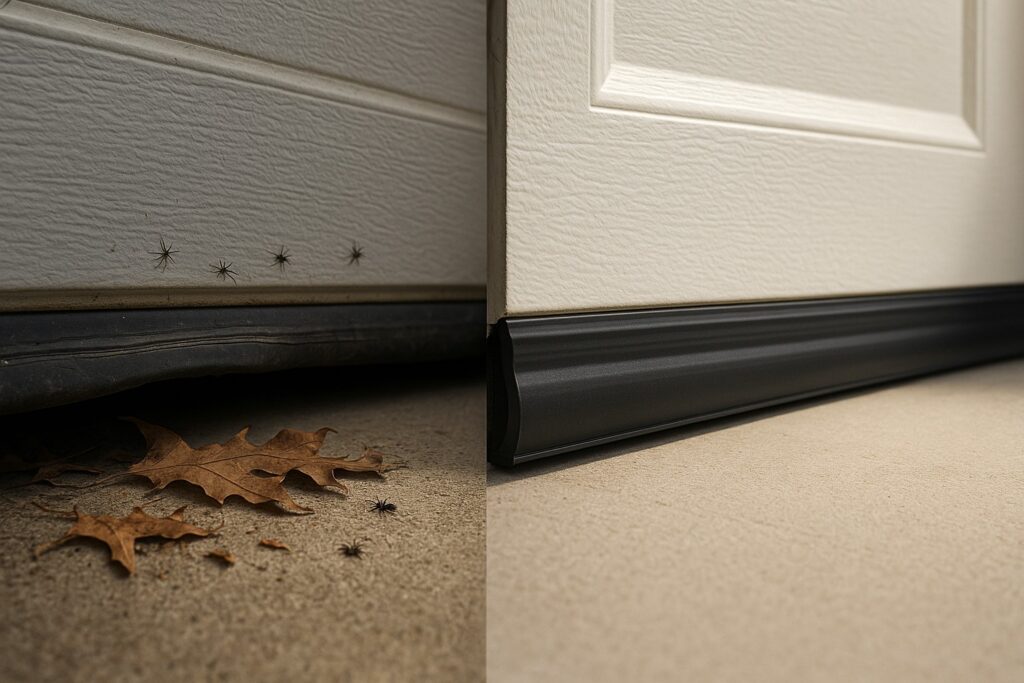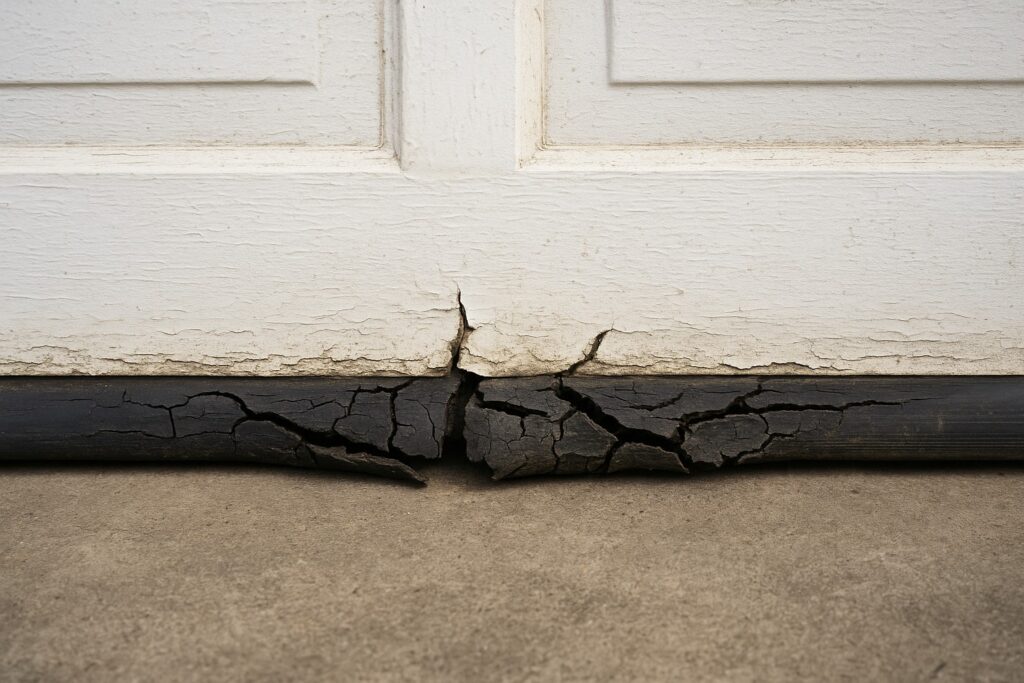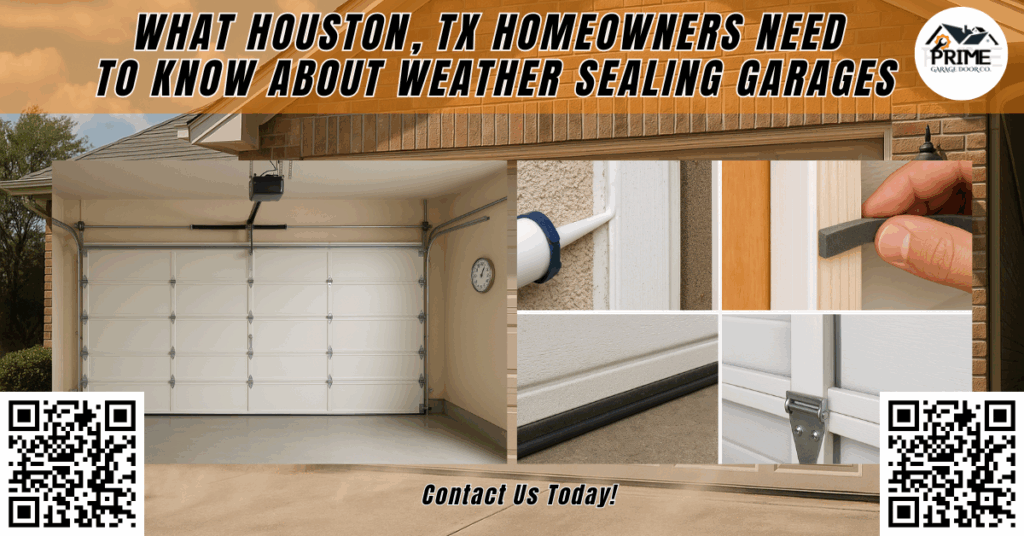In one memorable case, we received a late-night call from a Houston homeowner who discovered standing water and soaked cardboard boxes in their garage after a sudden thunderstorm. Despite having a relatively new garage door, the absence of a proper garage door seal, especially at the bottom, allowed rainwater to pour in. Their costly mistake? Neglecting to replace a deteriorated garage door bottom seal and failing to install a threshold seal for added protection.
According to the United States Department of Energy (DOE), inadequate weatherproofing can account for up to 30 percent of household energy waste. When you factor in Houston’s notoriously humid climate, temperature extremes, and frequent rainstorms, this statistic becomes even more critical for local homeowners. Simply put, weather sealing is not just about comfort; it is about preserving your property, reducing utility bills, and safeguarding your belongings from environmental damage.
If you own a home in Houston, understanding weather sealing and its implications can save you hundreds of dollars annually, prevent mold and pest infestations, and help you maintain a comfortable and energy-efficient garage. At Prime Garage Door Co., we want to ensure that you are equipped with the right information and tools to protect your investment year-round.
What Is Weather Sealing for Garages?
Weather sealing is the process of installing materials such as rubber door strips, foam seals, and vinyl sweeps around the garage door’s perimeter to block air leaks, moisture, dust, and pests from entering. These seals are placed along the bottom, sides, and top of the door to create an airtight barrier.
The primary purpose of garage door weatherproofing is to improve energy efficiency, prevent drafts, and keep external elements from intruding into your garage space. Proper door weather stripping and sealing contribute significantly to garage insulation by reducing the exchange of hot and cold air, which is particularly important in Houston’s fluctuating climate.
A well-sealed garage can prevent costly repairs, deter rodents and insects, and improve the overall comfort of adjacent indoor spaces, especially if your garage is attached to your home. By adding components like EPDM rubber strips, adhesive door seals, and aluminum thresholds, homeowners can ensure a more resilient and longer-lasting defense against Houston’s elements.
Why Weather Sealing Matters in Houston’s Climate
High Rainfall and Flood Risk
Houston averages nearly 50 inches of rainfall each year, placing it among the wettest major cities in the United States. Heavy downpours, especially during hurricane season, can lead to significant flooding if your garage is not properly sealed. Water intrusion can damage stored items, create hazardous electrical conditions, and weaken your garage’s structural foundation.
Sealing your garage with a combination of a high-quality garage door bottom seal and a well-installed threshold seal provides a crucial water barrier. Adding a draft stopper or installing an under-door seal helps create a watertight and airtight seal, even on slightly uneven garage floors.
Intense Summer Heat
Houston summers regularly see temperatures rise above 95 degrees Fahrenheit. When your garage lacks proper insulation and weatherproofing, this extreme heat can radiate into your home, increasing indoor temperatures and putting unnecessary strain on your HVAC system.
Installing foam seal tape, door sweep kits, and window insulation film can significantly reduce this heat transfer. Properly insulated garages can improve energy efficiency by as much as 15 percent, according to Energy Star, a program backed by the Environmental Protection Agency (EPA).
Pest and Insect Control
Warm weather combined with high humidity creates ideal conditions for ants, cockroaches, termites, and rodents. These pests often find entry through gaps in garage doors, especially around the bottom and sides. Using a combination of magnetic door strips, silicone sealant, and properly aligned side seals, you can create a pest-resistant barrier that minimizes the risk of infestation.

Types of Garage Door Weather Seals
Every part of your garage door needs attention when it comes to weatherproofing. The following are the most effective types of weather seals used in residential and commercial applications:
Bottom Seal
The garage door bottom seal is a flexible rubber or vinyl strip attached to the lower edge of the garage door. It compresses when the door is closed to form a tight seal against the floor. Common materials include EPDM rubber and vinyl, both of which are durable and resistant to temperature fluctuations.
Different profiles, such as bulb, T-style, and bead-style seals, are available to suit varying door configurations. When paired with an aluminum threshold and applied using installation adhesive, the bottom seal becomes an essential first line of defense.
Threshold Seal
Installed directly onto the garage floor, threshold seals create an elevated edge that reinforces the barrier formed by the bottom seal. These seals are especially useful in preventing water backflow during Houston’s flash floods.
Using a utility knife, measuring tape, and a sealant gun, threshold seals can be cut to size and glued into place for long-term performance. High-quality thresholds often feature ribbed EPDM rubber for better traction and sealing.
Side Seal
Side seals, also known as vinyl or foam weatherstripping, are attached vertically along the garage door frame. They prevent wind, rain, and pests from sneaking in through the sides. Vinyl trim or foam tape can be used here, depending on the size of the gap and the level of exposure.
A loose side seal can lead to increased condensation inside your garage, which in turn encourages rusting and mold growth.
Top Seal
The top of your garage door is often overlooked, but it can allow significant air leakage. Installing a top seal with a magnetic door strip or foam weatherstrip tape provides comprehensive coverage and enhances draft protection.
Brush Seals
These seals are ideal for commercial or high-use garage doors. Made from dense bristles, brush seals conform to irregular surfaces and maintain their shape despite frequent use. They offer excellent durability and are effective against both dirt and small pests.
Benefits of Weather Sealing Your Garage
Energy Efficiency and Cost Savings
One of the most tangible benefits of garage weather sealing is the reduction in heating and cooling costs. By sealing cracks and gaps, you prevent conditioned air from escaping and outside air from infiltrating your home. When used in combination with garage insulation and window caulking, you can expect lower energy bills and improved HVAC performance.
The American Society of Heating, Refrigerating, and Air-Conditioning Engineers (ASHRAE) recommends sealing all exterior penetrations in homes to meet energy efficiency standards. A properly sealed garage contributes significantly toward meeting those benchmarks.
Condensation and Mold Prevention
Houston’s humid climate can cause condensation to form on the inside of unsealed garage doors and walls. Moisture buildup promotes the growth of mold and mildew, which not only poses health risks but can also degrade stored belongings and building materials.
By using silicone caulk around the perimeter of your garage and installing a heat-shrink seal on windows, you can drastically reduce moisture intrusion. Periodic seal inspection helps catch early signs of deterioration before major issues arise.
Enhanced Comfort and Usability
Sealing your garage creates a more consistent internal environment. This is especially beneficial if your garage doubles as a workshop, fitness area, or laundry room. Tools and equipment are better protected from humidity, and the temperature remains more manageable throughout the year.
Adding a thermal curtain or foam weatherstrip to any adjoining interior doors further improves comfort and insulation.
Pest Deterrence and Structural Longevity
Pests can chew through weak or cracked seals. Regularly replacing deteriorated weather stripping, using stronger materials like EPDM rubber or reinforced adhesive rubber seal products, and conducting seal inspections each season help maintain a secure perimeter.
A well-sealed garage also reduces wear and tear on your garage door system by limiting the amount of moisture and dust that infiltrates hinges, tracks, and springs.
When and How to Replace Garage Door Seals
Garage door seals typically last between two to three years, depending on usage, weather exposure, and material quality. In Houston, high UV levels and frequent weather changes can shorten this lifespan.
Look out for these signs of seal failure:
- Cracked seals that feel brittle or torn
- Gaps where light passes through around the door perimeter
- Increased pest activity or dust buildup
- Noticeable temperature fluctuations inside the garage
- Presence of moisture, mold, or mildew

Seasonal replacement of seals, particularly before the onset of summer and hurricane season, ensures year-round protection. Use tools like miter shears, a heat gun, and a caulking gun for precise removal and installation. Always measure twice using a measuring tape before cutting a new seal.
DIY vs. Professional Garage Weatherproofing
While DIY weather sealing kits are available and often include foam tape, vinyl sweeps, and door sweep kits, homeowners may lack the precision tools and experience required for effective installation.
Professionals bring benefits such as:
- Accurate door and frame measurements
- Use of commercial-grade adhesive rubber seal and aluminum threshold materials
- Full perimeter sealing, including hard-to-reach areas
- Inspection for underlying issues like frame warping or water damage
At Prime Garage Door Co., we offer complete weather sealing packages that include foam weatherstrip tape, vinyl trim, door sweep kits, and professional installation adhesive to ensure a flawless seal.
Local Considerations for Houston Residents
Foundation Shifting and Soil Movement
Houston’s clay-rich soil tends to expand and contract, leading to shifting foundations. This can result in uneven garage floors and minor door misalignment. Installing a thicker threshold seal or an adjustable under-door seal can help maintain a tight seal despite ground movement.
Flood Zone Precautions
Homes in designated flood zones should invest in high-durability EPDM rubber threshold kits and sealed aluminum thresholds to withstand temporary flooding. Sealant guns and silicone caulk are essential tools for reinforcing vulnerable areas.
Seasonal Maintenance Recommendations
To keep your garage sealed and energy-efficient year-round, we recommend:
- Performing a seal inspection at the beginning of each season
- Replacing cracked seal components and loose door sweeps immediately
- Cleaning all seals with a mild detergent and a soft cloth to remove debris and grime
- Using a sealant gun to reapply adhesive door seal products as needed
Frequently Asked Questions (FAQs)
1. Can weather sealing a garage door help reduce noise from outside?
Yes, properly installed weather seals can act as a sound barrier by blocking gaps where noise enters. This is especially helpful if you live near a busy road or use your garage as a workspace.
2. What is the difference between EPDM rubber and vinyl for garage door seals?
EPDM rubber is more flexible and durable in extreme temperatures, making it ideal for Houston’s hot and humid climate. Vinyl is more rigid and affordable but may become brittle over time when exposed to UV rays.
3. Can I install weather seals on an old garage door, or do I need a new one?
You can install new weather seals on an older garage door as long as the door is still structurally sound. Replacing seals can extend the life of your existing door without the need for a full replacement.
4. How long does it take to professionally install weather sealing on a standard garage door?
A professional technician can usually complete a full weather sealing installation in about one to two hours. This includes measuring, trimming, and securing all seals around the perimeter of the door.
How Can Prime Garage Door Co. Help You?
At Prime Garage Door Co., our team of experienced technicians understands the unique weatherproofing needs of Houston homeowners. Whether you are dealing with heavy rains, blistering summer heat, or bothersome pests, we provide tailored weather sealing solutions that offer lasting results.
We offer:
- Complimentary weather seal inspections
- Custom-fit installations using premium materials
- Thorough garage sealing that includes the bottom seal, side seal, top seal, and threshold
- Repair and replacement of cracked or worn seals using industry-standard products like EPDM rubber and foam weatherstrip tape
- Recommendations for garage insulation, including thermal curtains and window insulation kits
Call us today at (281) 843-1139 or visit us at 5831 Centralcrest St 1st Floor, Houston, TX 77025 to schedule your weather sealing consultation. Let Prime Garage Door Co. help you protect your home, save on energy bills, and enjoy a more comfortable garage space all year long.
Final Thoughts
Weather sealing your garage is one of the smartest investments you can make as a Houston homeowner. It not only enhances energy efficiency and reduces utility costs but also protects your property from the city’s challenging climate conditions. With a range of sealing options available from rubber door strips and aluminum thresholds to adhesive seals and foam tape, there is a solution for every type of garage and budget.
By taking action today, whether through a professional installation or a strategic DIY project, you can prevent air leaks, keep pests at bay, and preserve your garage’s usability and comfort. Let this be the season you seal out the elements and seal in long-term value.
If you are ready to take the next step toward weatherproofing your garage, reach out to Prime Garage Door Co. for expert guidance and reliable service. We are here to help you weather every storm, one seal at a time.

